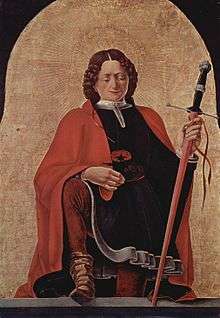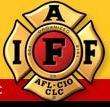Saint Florian
Saint Florian (Latin: Florianus; 250 – c. 304 AD) was a Christian holy man, and the patron saint of Linz, Austria; chimney sweeps; soapmakers, and firefighters. His feast day is 4 May. St. Florian is also the patron of Upper Austria, jointly with Saint Leopold.
Saint Florian | |
|---|---|
 Saint Florian by Francesco del Cossa, 1473 | |
| Born | 250 AD Aelium Cetium (present-day Sankt Pölten, Austria), Roman Empire |
| Died | c. 304 AD Enns (river) |
| Venerated in | Roman Catholic Church Eastern Orthodox Church[1] |
| Feast | 4 May |
| Attributes | depicted as a Roman officer or soldier; pitcher of water; pouring water over fire; invoked against fire, floods and drowning[2] |
| Patronage | Linz, Austria; Kraków, Poland; chimneysweeps; firefighters; soap boilers; Upper Austria |
Life
St. Florian was born around 250 AD in the ancient Roman city of Aelium Cetium, present-day Sankt Pölten, Austria. He joined the Roman Army and advanced in the ranks,[3] rising to commander of the imperial army in the Roman province of Noricum. In addition to his military duties, he was also responsible for organizing and leading firefighting brigades. Florian organized and trained an elite group of soldiers whose sole duty was to fight fires.[4]
During the Diocletianic Persecution of Christians, reports reached Rome that St. Florian was not enforcing the proscriptions against Christians in his territory. Aquilinus was sent to investigate these reports. When Aquilinus ordered Florian to offer sacrifice to the Roman gods in accordance with Roman religion, Florian refused. Florian was sentenced to be burned at the stake. Standing on the funeral pyre, Florian is reputed to have challenged the Roman soldiers to light the fire, saying "If you wish to know that I am not afraid of your torture, light the fire, and in the name of the Lord I will climbe onto it."[5] Apprehensive of his words, the soldiers did not burn Florian, but executed him by drowning him in the Enns River with a millstone tied around his neck.[3][4]
His body was later retrieved by Christians and buried at an Augustinian monastery near Lorch. Later a woman named Valeria had a vision in which she saw him; Florian, in this vision, declared his intent to be buried in a more appropriate location.
Veneration
Saint Florian is very widely venerated in Central Europe.[6] The Austrian town of Sankt Florian is named after him. According to legend, his body was interred at St. Florian's Priory, around which the town grew up. His body, recovered and was eventually removed to the Augustinian Abbey of St. Florian, near Linz, Austria.[7]
Saint Florian was adopted as patron saint of Poland in 1184, when Pope Lucius III consented to the request of Prince Casimir II to send relics of Florian to that country.[3] Kraków thus claims some of his relics.[6]
A statue of Florian by Josef Josephu was unveiled in Vienna in 1935. It stood at the main firehouse of Vienna, in the city's main square, Am Hof. After the firehouse was bombed in 1945 during World War II the statue was moved on to the Fire Brigade Museum (Wiener Feuerwehrmuseum).[2]
Seeking the sponsorship of a helpful saint was and still is a part of the namegiving practice in Catholic areas. In the southern, Catholic parts of the German Empire (mainly present Bavaria and Austria), peasants regularly have used the name, Florian, as one of the given names for at least one of their male children: to secure the saint's patronage against fire. Hence the given name is still widespread in these areas.[8]
In Austria and Germany, fire services use Florian in radio communications as universal call sign for fire stations and fire trucks. The call sign Florentine for firefighting-related, hand held radio equipment is also derived, somewhat inaccurately, from that usage.
Patronage
St. Florian is the patron of Austria and Poland; also firefighters, chimney sweeps, and brewers. He is invoked against fires, floods, lightning, and the pains of purgatory.[9]
A famous St. Florian's Church is located in Kraków. His veneration has been particularly intense since 1528, when a fire burned the neighborhood without destroying the church.[10]
St. Florian's Cross Myth
The Firefighter's Cross, widely used as the symbol for firefighters, especially in the United States, has often been falsely attributed to St. Florian.[11] There is no historical evidence for this, and no association with any form of the Firefighter's Cross is found before the 20th century when St. Florian medals began to be struck on what was already widely recognized as the Firefighter's Cross.
The cross is sometimes also confused with the Maltese cross.[12][13][14][15] The Maltese cross is a sharp eight-pointed cross, in the form of four arrowheads whose points touch, whereas the firefighter's has rounded arcs between the four points. .[16]
 Firefighter's cross
Firefighter's cross Firefighter's cross variant
Firefighter's cross variant Maltese cross
Maltese cross Fort Johnson Volunteer Fire Company
Fort Johnson Volunteer Fire Company FDNY memorial flag
FDNY memorial flag Jacksonville Fire and Rescue
Jacksonville Fire and Rescue International Association of Firefighters
International Association of Firefighters
In contemporary culture
The "Florian Principle" (known in German language areas as "Sankt-Florians-Prinzip") is named after a somewhat ironic prayer to Saint Florian: "O heiliger Sankt Florian, verschon' mein Haus, zünd' and're an", equivalent to "O Holy St. Florian, please spare my house, set fire to another one". This saying is used in German much like the English "not in my back yard", when the speaker wants to point out that some person tries to get out of an unpleasant situation by an action that will put others in that very same situation.
The name Florian is considered synonymous with fireman in the German speaking world. In some cases call for a fireman will actually be spoken as calls for Florian.
The protagonist in Felix Salten’s novel Florian: The Emperor’s Stallion was named after Saint Florian, as the animal was born on 4 May in Lipizza, Austria.[17]
Alfred Schnittke's Symphony No. 2, is subtitled "St. Florian".[18]
Gallery
 St. Florian in St. Andrew's Church in Andraž nad Polzelo (Slovenia)
St. Florian in St. Andrew's Church in Andraž nad Polzelo (Slovenia) Bas-relief of St. Florian on the Florian Gate of Kraków.
Bas-relief of St. Florian on the Florian Gate of Kraków..jpg)

- Statue of St. Florian at a crossroads near Komarówka Podlaska (Poland)
- Statue of Saint Florian, located above the altar at Saint Florian Catholic Church in Ino, Wisconsin, and Hatley, Wisconsin, United States.
See also
- St. Florian's Church in Kraków, the resting place of St. Florian's relics
References
- (in Greek)Ὁ Ἅγιος Φλωριανὸς ὁ Μάρτυρας. 4 Μαΐου. ΜΕΓΑΣ ΣΥΝΑΞΑΡΙΣΤΗΣ.
- Mendler, Mitch. "Saint Florian – the patron saint of the fire service". Retrieved 16 January 2019.
- "St. Florian", Saint Florian Roman Catholic Church
- "St. Florian History", Brookline Firefighters Association, Brookline, Massachusetts.
- Turkalj, Nikola (2018). Rimski vojnik i vatrogasac. Split: Redak. p. 19. ISBN 978-953-336-489-6.
- St. Florian - Catholic Online
- "The story of Saint Florian, the patron saint of the fire service", City of Columbia, Missouri
- For the frequency of this given name in Germany type "Florian"
- Lanzi, Fernando and Lanzi, Gioia: "Florian of Lorch, Martyr", Saints and Their Symbols: Recognizing Saints in Art and in Popular Images, p. 86. Liturgical Press, 2004. ISBN 0-8146-2970-9
- Internetowa Liturgia Godzin, brewiarz.pl; accessed 29 June 2020 (Polish).
- Just Another Medic (9 August 2020). "The Myth of the "Maltese" Cross in the American Fire Service". Just Another Medic. Retrieved 9 August 2020.
- "The Cross of Saint Florian", Waynesville Rural Fire Protection District
- "Maltese Cross" IAFF Local 1568
- "Why is the NDFD emblem the shape of a Maltese Cross?", University of Notre Dame Fire Department
- "Saint Florian Patron Saint of Fire Fighters", Mokena Professional Firefighters Local 4270
- "The Maltese Cross... Or Is It the St. Florian Cross?", Fire-Dex, 15 November 2013
- Salten, Felix (1934). Florian: The Emperor’s Stallion. Translated by Erich Posselt and Michel Kraike. Indianapolis: The Bobbs-Merrill Company. p. 17.
- Ivashkin, Alexander: Alfred Schnittke, p. 141. London: Phaidon Press Limited, 1996. ISBN 0-7148-3169-7
External links
| Wikimedia Commons has media related to Saint Florian. |
| Wikisource has the text of an 1879 American Cyclopædia article about Saint Florian. |
- Catholic Online article
- The Cult of St. Florian (with primary sources)
- St. Florian's Abbey in Austria
- Saint Florian the patron saint of the fire service
- Saints of Suds
- Firefighter's Cross symbols on historic firefighting objects, Staten Island Historical Society Online Collections Database
- Saint Florian at the Christian Iconography web site
- The Myth of the "Maltese" Cross in the American Fire Service"/